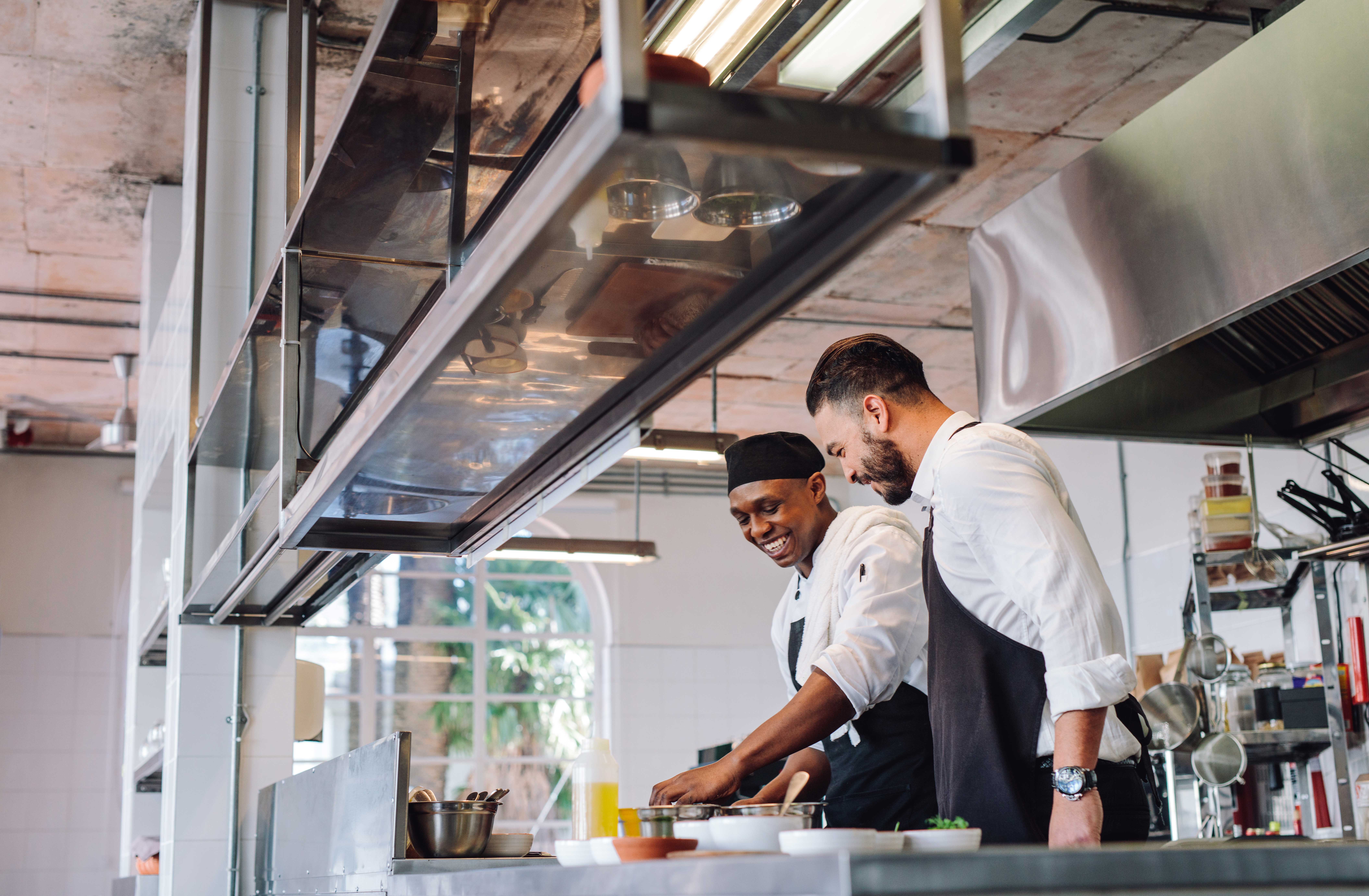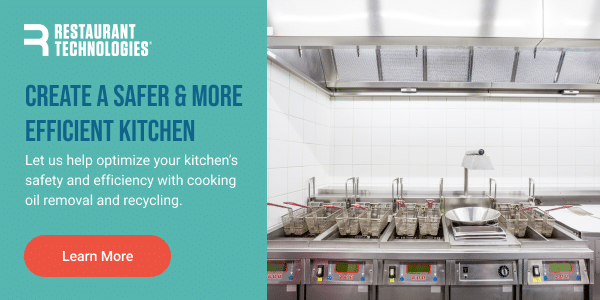
Updated March 18, 2024
Maneuvering scalding liquids, sifting hot pans, and dodging open flames are a daily occurrence in commercial and restaurant kitchens. It’s no surprise, then, that food service workers are more than 6 times as likely to suffer burn injuries on the job than in any other industry—even manufacturing and construction.1
In addition to the risk of permanent physical damage, serious burn injuries often mean lost work time and they open up the possibility of costly workers’ compensation claims. For these reasons and more, the question of how to prevent burns in the kitchen is a crucial one.
What can you do to try to guarantee your team’s safety? By understanding common risk factors, putting preventative measures in place, and leveraging new technology, restaurants can minimize the risk of burns—ensuring a danger-free and enjoyable work environment.
Understanding the Risk
A kitchen contains many hazards that can cause burns. Splatters, spills, and slippery floors are common factors that contribute to the thousands of burn injuries restaurant workers report every year.
Yet among these risk factors, one stands out as responsible for the most severe injuries: hot oil.
Scalding due to hot grease and oil is the leading cause of burns in restaurant settings,2 often associated with the use of deep fryers and associated tasks such as:
- Filtering and replacing cooking oil for deep frying
- Cleaning and operating deep frying equipment
- Carrying receptacles filled with cooking oil
Filtering cooking oil and reusing it can save your restaurant money in the long run and improve your business’s sustainability. Understanding how to reduce food waste in restaurants can further reduce your costs.
Additionally, many workers in the restaurant industry tend to be quite young, with nearly 30% of the restaurant workforce under 20 years of age.3 The right equipment, training, and an environment where they feel comfortable asking questions or for assistance are all crucial to ensuring safe fryer operations.

Types of Burns and Their Impacts
While hospitalization for burns is uncommon, they are still debilitating, sometimes requiring expensive treatment. Beyond the immediate physical pain, these injuries can also lead to significant scarring, emotional distress, and, in severe cases, infections that complicate the healing process.
There are three degrees of burns to be aware of:
- First-degree burns only affect the outer layers of skin, causing redness and pain.
- Second-degree burns tend to be the most painful, affecting tissues below the skin. They often result in peeling, blistering skin, swelling, and leaking pus.
- Third-degree burns are the most severe, penetrating deeper layers of skin and potentially causing permanent nerve, tissue, and even bone damage.
The type of burn (and resulting impact) depends heavily on how it happened. Brief contact with a hot surface may only result in first-degree burns, with no residual effects once healed. Accidents involving hot liquids, such as cooking oil, can be far more severe—possibly even resulting in long-term disability or disfigurement.4This is another reason to consider commercial cooking oil management.
Responding to Burns in the Kitchen
Hot oil from a fryer can sometimes exceed 375°F.5 This can easily cause third-degree burns in more severe cases. However, hot countertops, cookware, and even steam can also cause minor burns that require treatment.
Ensure that your kitchen is ready to respond to burns with a properly outfitted first-aid kit. Employees need to be properly trained in fire safety and burn prevention to understand the risks of cooking with hot liquid and avoid a grease fire. All staff should be trained to respond to a minor burn injury, using a procedure similar to the following6:
- Cool the burn under cool (not cold) running water for about 10 minutes.
- After cooling, apply aloe vera, lotion, or burn cream to the site.
- Cover with a sterile bandage or clean cloth. Wrap loosely to avoid creating pressure or breaking blisters.
While prioritizing safety and avoiding burns in the first place is always best, acting quickly to treat minor burns can help prevent infection before the individual seeks out professional care.
Frequently Asked Questions
The discussion of more severe burns in commercial kitchen settings often raises additional questions. Let’s briefly consider a few of the more common ones:
How do you treat burns from frying oil?
In the case of serious oil burns, immediately remove the person from the source of the burn and any other danger. Call for medical assistance as soon as possible.
Remove any rings, jewelry, belts, or other tight items from the burn site, as it can start swelling quickly. If possible, remove clothing from the affected area—do not attempt to remove clothing that is stuck or fused to the skin.
For extremely severe burns where the skin appears charred, white, or missing, do not apply any water or ointments. Cover the affected area with a clean cloth and watch the individual for signs of shock (clammy skin, weak pulse, shallow breathing) while waiting for medical attention.6
Do fryer oil burns go away?
It depends on the situation. Most minor burns (such as those caused by small splashes) may heal without leaving significant marks. More severe burns, such as those caused by spilling oil on yourself or a team member without protective equipment, may result in lasting scars.
How long does a cooking oil burn take to heal?
Healing time varies, depending on the individual and the severity of the burn. A minor cooking oil burn can heal within a week, while more serious burns require months and medical intervention to properly heal. Make sure to consult with a medical professional to determine the right treatment plan while recovering.7
Preventative Measures in the Kitchen
The potential for burns in a kitchen environment is significant, but with proactive measures, such incidents are largely preventable. While each team member has the responsibility to work safely, restaurants can do much to prevent burn injuries:
- Kitchen layout – A thoughtfully designed kitchen layout is critical in minimizing burn risks. By reducing the necessity to transport hot liquids across the kitchen and ensuring ample cooking space, the chance of spills and overcrowding in work areas is significantly decreased.
- Safety features – Automated fryers and oil management systems significantly reduce the chance of burns, instantly boosting the safety of your kitchen. Installing splash guards and equipping floors with anti-slip mats further mitigate the risk of burns from spills and splatters.
- Provide equipment and training – Personal protective equipment (PPE) such as heat-resistant gloves, aprons, and face shields can safeguard team members from accidental splashes and spills. All back-of-house staff should receive extensive safety training, best practices in the kitchen, and how to use restaurant PPE.
Investing upfront in safer equipment and robust training policies pays dividends. Your team can enjoy smoother operations, better morale, and reduced risk of costly burn injuries. Whether you’re cooking in a deep fryer or on a hot griddle, follow kitchen safety procedures to prevent kitchen burns and reduce the chances of having to visit a nearby burn center.
Best Practices for Handling Cooking Oil
Since hot cooking oil is the largest risk for kitchens when it comes to burn injuries, there are several best practices to keep in mind:
- Practice temperature management – Keeping a close eye on oil temperatures with accurate thermometers and recommended temperature settings can help prevent overheating, reducing the risk of oil boiling over and hot liquid burning a staff member.
- Perform regular cleaning and maintenance – Ensure that all equipment involving oil, such as fryers, is regularly cleaned and maintained according to manufacturer guidelines. This prevents oil buildup, which can increase the risk of burns and grease fires. Regular checks for wear and tear can also identify potential hazards before they become serious. Set clear restaurant cleaning procedures for staff to follow regarding cooking oil.
- Use high-quality oil – Opting for high-quality cooking oil can reduce the frequency of changes needed, as it tends to break down more slowly at high temperatures. This not only improves safety by reducing the handling of hot oil but also enhances the flavor and quality of the food.
- Avoid overfilling – Overfilling fryers with oil can lead to spills and splatters when adding or removing food, significantly increasing burn risks. Always adhere to the maximum fill line and take into consideration the displacement caused by food being added to the oil. Lower food items into the fryer gently with baskets or tongs to minimize splashing.
- Transport oil carefully – When moving hot oil, use containers designed for high temperatures and ensure they are securely covered to prevent spills. Employing tools like oil caddies for used oil can also minimize the need for manual handling, reducing exposure to hot surfaces and liquids.
In case of emergencies, it is also necessary to have a Class K fire extinguisher nearby.2 Grease fires can be dangerous not just to staff, but also to customers and the restaurant structure. Research other restaurant fire safety guidelines to ensure your customers and staff are protected.
Prevent Burns with a Total Oil Management Solution
The most effective way to prevent oil burns is minimizing direct handling through an automated total oil management solution. This enclosed system filters, stores, and disposes of your restaurant’s cooking oil—with absolutely zero manual contact needed.
Without the need to empty and refill fryer vats or deal with messy waste oil, you protect your back-of-house team from a commercial kitchen’s single biggest danger.
This translates to more engaged staff, higher retention, and a kitchen that’s both safe and efficient. Explore and implement restaurant safety tips to further enhance your employees’ experience.
Restaurant Technologies: Your Partner in Total Oil Management
At Restaurant Technologies, we’ve revolutionized the way commercial kitchens handle cooking oil. We work with you to tailor an oil management solution perfect for you—whether you’re an independent restaurant, a national chain, or even a non-commercial food service.
By automating the delivery, filtration, and disposal of cooking oil, Restaurant Technologies ensures a safer working environment, reducing the potential for slips, falls, strains, and burns. Our systems have even helped restaurants achieve up to 15% savings on insurance premiums due to the reduced risk. Consider investigating other restaurant efficiency tips that can create a safer working environment and reduce costs,
Choosing Restaurant Technologies as your partner in total oil management means investing in the safety of your kitchen staff and the sustainability of your operations. Reach out to us today and see if we can find a solution for you.
Sources:
- U.S. Bureau of Labor Statistics. Injury and illness rates higher in special food services than in broader food services industry. https://www.bls.gov/opub/ted/2019/injury-and-illness-rates-higher-in-special-food-services-than-in-broader-food-services-industry.htm
- OSHA. Young Worker Safety in Restaurants – Cooking. https://www.osha.gov/etools/young-workers-restaurant-safety/cooking
- OSHA. Young Worker Safety in Restaurants. https://www.osha.gov/etools/young-workers-restaurant-safety
- Maryland Department of Health. Indicator #6: Hospitalizations for Work-Related Burns. https://health.maryland.gov/phpa/OEHFP/EH/pages/Health-Indicator-6.aspx
- OSU. Deep Fat Frying Basics for Food Services. https://extension.okstate.edu/fact-sheets/deep-fat-frying-basics-for-food-services.html
- Mayo Clinic. Burns: First aid. https://www.mayoclinic.org/first-aid/first-aid-burns/basics/art-20056649
- Complete Care. How to Treat a Cooking Burn. https://www.visitcompletecare.com/blog/cooking-oil-burn-treatment/